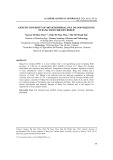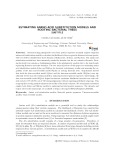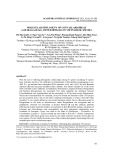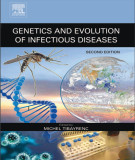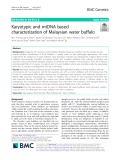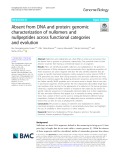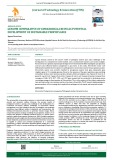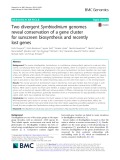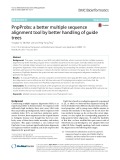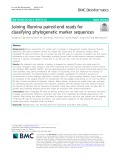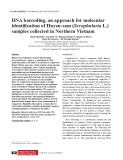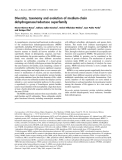
Phylogenetic classifiers
-
The Tajima’s test indicated that the analysed population in balancing selection with a D-value of 2.39. A phylogenetic tree based on 455 bp of hypervariable mtDloop sequence classified 17 Bang Troi chicken individuals into three clades A, B, and E, which are common groups of Vietnamese and Asia indigenous chickens. This result provides the first genetic information and maternal lineages of Bang Troi chickens and it can support for registration of local chicken breeds.
 6p
6p  dianmotminh02
dianmotminh02
 03-05-2024
03-05-2024
 2
2
 1
1
 Download
Download
-
Reconstructing phylogenetic trees from protein sequences normally requires empirical amino acid substitution models to calculate the likelihood of trees or genetic distances between species. The tree of life is classified into three domains of Eukaryotes, Archaea, and Bacteria. The amino acid substitution models have been intensively studied for decades, but few are related to Bacteria. Rooting bacterial trees remains a challenging problem in the phylogenetic analysis due to the long branch separating Bacteria and other domains.
 14p
14p  dianmotminh02
dianmotminh02
 03-05-2024
03-05-2024
 4
4
 2
2
 Download
Download
-
With the aim of inferring phylogenetic relationships among 86 species (including 45 species from Vietnam) mostly of the subfamily Convallarioideae (=Nolinoideae) (Asparagaceae sensu APG IV), we analyzed their chloroplast DNA sequences (rbcL and trnL-F) by both Bayesian inference (BI) and maximum likelihood (ML) methods. Our dataset included six of the seven tribes classified in this subfamily; Convallarieae, Dracaeneae, Liriopeae Nolineae, Polygonateae and Rusceae (Eriospermeae not examined).
 17p
17p  dianmotminh02
dianmotminh02
 03-05-2024
03-05-2024
 3
3
 2
2
 Download
Download
-
Part 1 book "Genetics and evolution of infectious diseases" includes content: Recent developments in the definition and official names of virus species; a theory based pragmatism for discovering and classifying newly divergent species of bacterial pathogens, population structure of pathogenic bacteria, epidemiology and evolution of fungal pathogens in plants and animals, clonal evolution, coevolution of host and pathogen, microbes as tracers of past human demography and migrations, phylogenetic analysis of pathogens,... and other contents.
 332p
332p  oursky07
oursky07
 23-10-2023
23-10-2023
 6
6
 1
1
 Download
Download
-
In Malaysia, the domestic water buffaloes (Bubalus bubalis) are classified into the swamp and the murrah buffaloes. Identification of these buffaloes is usually made via their phenotypic appearances. This study characterizes the subspecies of water buffaloes using karyotype, molecular and phylogenetic analyses.
 6p
6p  vihagrid
vihagrid
 30-01-2023
30-01-2023
 3
3
 3
3
 Download
Download
-
Nullomers and nullpeptides are short DNA or amino acid sequences that are absent from a genome or proteome, respectively. One potential cause for their absence could be their having a detrimental impact on an organism.
 24p
24p  viarchimedes
viarchimedes
 26-01-2022
26-01-2022
 7
7
 0
0
 Download
Download
-
In this study, Edwardsiella strains were differentially classified into four species by a phylogenomics construction based on the pan-genome analysis. Edwardsiella species were correctly classified by pan-genome analysis (core gene, dispensable gene, singleton gene) of 15 complete genomes.
 3p
3p  viwilliamleiding
viwilliamleiding
 10-12-2021
10-12-2021
 16
16
 1
1
 Download
Download
-
The marine dinoflagellate, Symbiodinium, is a well-known photosynthetic partner for coral and other diverse, non-photosynthetic hosts in subtropical and tropical shallows, where it comprises an essential component of marine ecosystems. Using molecular phylogenetics, the genus Symbiodinium has been classified into nine major clades, A-I, and one of the reported differences among phenotypes is their capacity to synthesize mycosporine-like amino acids (MAAs), which absorb UV radiation.
 11p
11p  vibeauty
vibeauty
 23-10-2021
23-10-2021
 10
10
 0
0
 Download
Download
-
This paper describes a new MSA tool called PnpProbs, which constructs better multiple sequence alignments by better handling of guide trees. It classifies sequences into two types: normally related and distantly related.
 11p
11p  vioklahoma2711
vioklahoma2711
 19-11-2020
19-11-2020
 16
16
 1
1
 Download
Download
-
Illumina sequencing of a marker gene is popular in metagenomic studies. However, Illumina paired-end (PE) reads sometimes cannot be merged into single reads for subsequent analysis. When mergeable PE reads are limited, one can simply use only first reads for taxonomy annotation, but that wastes information in the second reads.
 13p
13p  vicolorado2711
vicolorado2711
 22-10-2020
22-10-2020
 11
11
 0
0
 Download
Download
-
Huyen-sam (Vietnamese name) which belongs to Scrophularia L. genus is a valuable herb. This medicinal plant is classified as Scrophularia ningpoensis Hemsl. Huyen-sam roots, which contain a large amount of bioactive compounds, have a similar morphology to its relatives. DNA barcodes promise to be a precise and reliable tool for distinguishing the processed Huyen-sam materials from their counterfeits. However, studies about using DNA barcodes for classification of Scrophularia L. in Vietnam are not available. Here, we conducted a taxonomic analysis of eight Scrophularia L.
 9p
9p  caygaocaolon1
caygaocaolon1
 13-11-2019
13-11-2019
 9
9
 0
0
 Download
Download
-
Acomprehensive, structural and functional, insilicoanalysis of the medium-chain dehydrogenase/reductase (MDR) superfamily, including 583 proteins, was carried out by use of extensive database mining and theBLASTPprogram in an iterative manner to identify all known members of the superfamily. Based on phylogenetic, sequence, and func-tional similarities, the protein members of the MDR super-family were classified into three different taxonomic categories: (a) subfamilies, consisting of a closed group containing a set of ideally orthologous proteins that perform the same function;...
 26p
26p  tumor12
tumor12
 20-04-2013
20-04-2013
 33
33
 3
3
 Download
Download
CHỦ ĐỀ BẠN MUỐN TÌM








